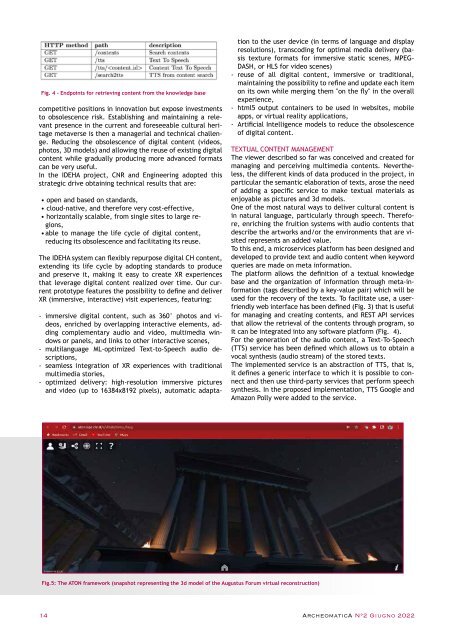Archeomatica 2 2022
Tecnologie per i Beni Culturali
Tecnologie per i Beni Culturali
You also want an ePaper? Increase the reach of your titles
YUMPU automatically turns print PDFs into web optimized ePapers that Google loves.
Fig. 4 - Endpoints for retrieving content from the knowledge base<br />
competitive positions in innovation but expose investments<br />
to obsolescence risk. Establishing and maintaining a relevant<br />
presence in the current and foreseeable cultural heritage<br />
metaverse is then a managerial and technical challenge.<br />
Reducing the obsolescence of digital content (videos,<br />
photos, 3D models) and allowing the reuse of existing digital<br />
content while gradually producing more advanced formats<br />
can be very useful.<br />
In the IDEHA project, CNR and Engineering adopted this<br />
strategic drive obtaining technical results that are:<br />
• open and based on standards,<br />
• cloud-native, and therefore very cost-effective,<br />
• horizontally scalable, from single sites to large regions,<br />
• able to manage the life cycle of digital content,<br />
reducing its obsolescence and facilitating its reuse.<br />
The IDEHA system can flexibly repurpose digital CH content,<br />
extending its life cycle by adopting standards to produce<br />
and preserve it, making it easy to create XR experiences<br />
that leverage digital content realized over time. Our current<br />
prototype features the possibility to define and deliver<br />
XR (immersive, interactive) visit experiences, featuring:<br />
- immersive digital content, such as 360° photos and videos,<br />
enriched by overlapping interactive elements, adding<br />
complementary audio and video, multimedia windows<br />
or panels, and links to other interactive scenes,<br />
- multilanguage ML-optimized Text-to-Speech audio descriptions,<br />
- seamless integration of XR experiences with traditional<br />
multimedia stories,<br />
- optimized delivery: high-resolution immersive pictures<br />
and video (up to 16384x8192 pixels), automatic adaptation<br />
to the user device (in terms of language and display<br />
resolutions), transcoding for optimal media delivery (basis<br />
texture formats for immersive static scenes, MPEG-<br />
DASH, or HLS for video scenes)<br />
- reuse of all digital content, immersive or traditional,<br />
maintaining the possibility to refine and update each item<br />
on its own while merging them "on the fly" in the overall<br />
experience,<br />
- html5 output containers to be used in websites, mobile<br />
apps, or virtual reality applications,<br />
- Artificial Intelligence models to reduce the obsolescence<br />
of digital content.<br />
TEXTUAL CONTENT MANAGEMENT<br />
The viewer described so far was conceived and created for<br />
managing and perceiving multimedia contents. Nevertheless,<br />
the different kinds of data produced in the project, in<br />
particular the semantic elaboration of texts, arose the need<br />
of adding a specific service to make textual materials as<br />
enjoyable as pictures and 3d models.<br />
One of the most natural ways to deliver cultural content is<br />
in natural language, particularly through speech. Therefore,<br />
enriching the fruition systems with audio contents that<br />
describe the artworks and/or the environments that are visited<br />
represents an added value.<br />
To this end, a microservices platform has been designed and<br />
developed to provide text and audio content when keyword<br />
queries are made on meta information.<br />
The platform allows the definition of a textual knowledge<br />
base and the organization of information through meta-information<br />
(tags described by a key-value pair) which will be<br />
used for the recovery of the texts. To facilitate use, a userfriendly<br />
web interface has been defined (Fig. 3) that is useful<br />
for managing and creating contents, and REST API services<br />
that allow the retrieval of the contents through program, so<br />
it can be integrated into any software platform (Fig. 4).<br />
For the generation of the audio content, a Text-To-Speech<br />
(TTS) service has been defined which allows us to obtain a<br />
vocal synthesis (audio stream) of the stored texts.<br />
The implemented service is an abstraction of TTS, that is,<br />
it defines a generic interface to which it is possible to connect<br />
and then use third-party services that perform speech<br />
synthesis. In the proposed implementation, TTS Google and<br />
Amazon Polly were added to the service.<br />
Fig.5: The ATON framework (snapshot representing the 3d model of the Augustus Forum virtual reconstruction)<br />
14 ArcheomaticA N°2 Giugno <strong>2022</strong>


















